Learning how to start seeds in trays can save you a bundle while allowing you to grow many unique plants at home.
For example, Minetto Lettuce is the standard variety sold at garden centers on our island. However, since I sow my own seeds, I can also grow Red Leaf, Black Seeded Simpson, and Romaine Lettuce year round.
Some plants require special conditions, such as simulating “seasonal” conditions, to germinate. Yet, for the most part, the process is similar across the board.
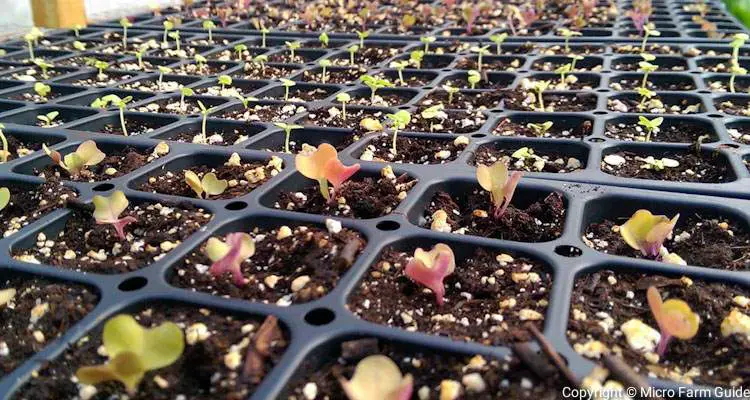
In this article, you will learn a basic step-by-step process I use to start seeds indoors and a simple technique you can use for hard-to-germinate varieties.
Before You Get Started…
You will need to collect the materials to set up your “seed start station.” Chances are, you already have some of these items at home. Here is a list of things you will need.
| Items | Details |
| Assortment Of Seeds | Choose vegetables and herbs you normally use at home |
| Modular Seedling Tray Or Kit | Use large-cell modular trays or similar such as eggcarton |
| Seed-Start Or Potting Mix | Use sifted compost or low-nutrient potting mix such a Pro-mix |
| Pieces Of Cardboard | To cover the tray after sowing |
| Sealed Seedling Tray | It should be large enough for the trays to fit and sealed to hold water |
| Seed Labels | Use pen and masking tape, popsicle sticks or plant labels |
| Watering Can | Should have a shower nozzle and be small enough to lift easily when full |
| Liquid Organic Fertilizer | To be applied after seedling produce their true leaves |
| Compost & Mulching Material | To retain water and keep green algae for forming on surface of potting mix |
| Garden Hand Tools | Seedling shovel, hand fork, micro-tip pruners, etc. |
| Sharp Knife And Scissors | Will come in handy |
| Notepad Or Calendar | To keep planting records |
You can purchase individual items such as seeds or a complete seed-start kit if you wish. Ensure you confirm what you have at home first, before making any decisions. Now, let’s move onto the steps.
How To Sow Seeds In Trays (Multi-sow Technique)
There are several ways to sow seeds in trays. However, I usually suggest to start with the multisow technique taught by Mr. Charles Dowding. It is easy to use and can be modified to suit your needs.
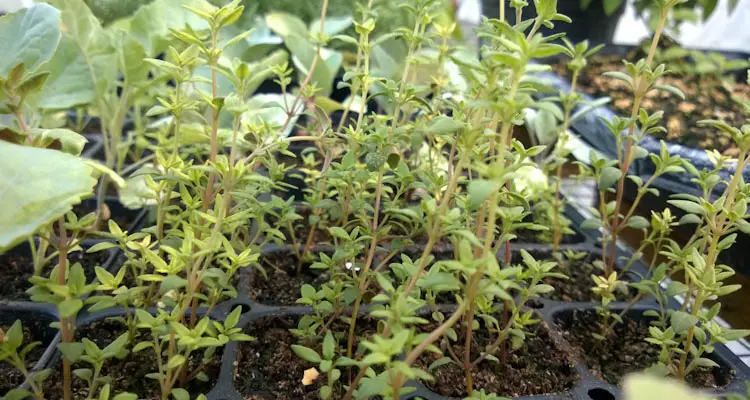
1. Fill Tray With Moist Potting Mix
To begin, you should moisten some potting mix or compost until it becomes dark and fluffy.
Next, fill the tray with the growing media. Tap gently on a table to settle the “soil” in the tray.
Remove excess material by sliding your hand across the top.
2. Sow Seeds In Cells
Poke a hole with your finger or piece of stick about ¼ deep and place seeds into it. Cover them with potting mix and press gently.
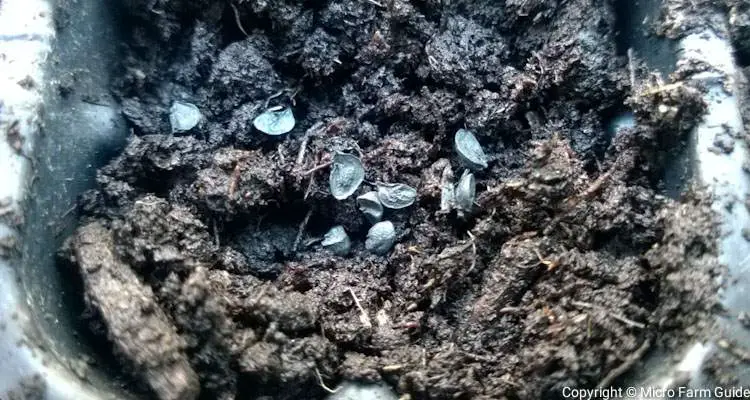
Here is an example of the suggested number of seeds per cell, but do not worry if you are not exact. Some seeds are tiny!
| Plants | Seeds Per Cell | Plants Per Cell |
| Basil | 4 | 2 |
| Beetroot | 4 | 4 |
| Bunching Onion | 6 | 4 |
| Chard (Salad) | 4 | 3 |
| Dill, Parsley | 3 | 2 |
| Kale | 4 | 3 |
| Onion Bulbs | 6 | 4 |
| Radish | 6 | 4 |
| Lettuce, Cabbage* | 2 | 1 |
| Spinach (Salad) | 4 | 3 |
The multisow technique is only recommended for some seeds, but I use it for almost everything. However, this means that I need to thin plants such as lettuce and cabbages which grow better as singles.
3. Label Trays And Record Planting
After sowing seeds, you should label the tray and note the variety planted and the date you started them to keep track of their progress.
You can create labels using masking tape or popsicle sticks. Feel free to get fancy and purchase plant labels. They look really cool, but are unnecessary at this point.
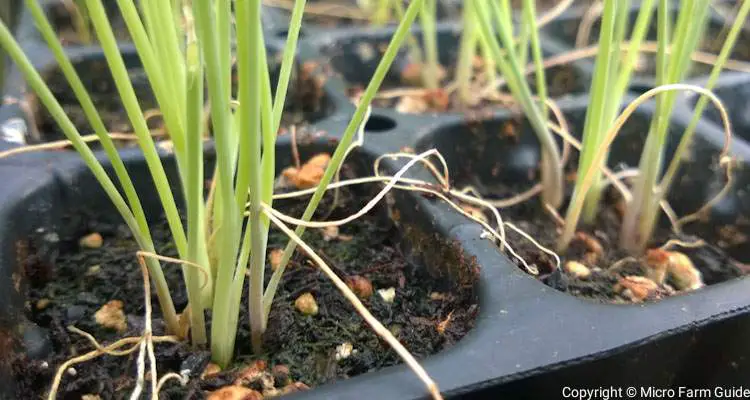
4. Water Seeds And Keep Moist
Afterward, fill the sealed seedling tray with about an inch of water and place the trays with seeds into the water. The water will “wick up” the growing media in a few minutes.
I prefer watering newly-planted seeds from the bottom to avoid disturbing or washing seeds away. However, you can also use a small watering can to do so. Remove the tray from the water once the media becomes wet.
Cover the tray with a piece of cardboard or a plastic dome and place it in a warm spot until they germinate.
5. Move Seedlings To Well-lit Area
Monitor your seed-start container for the first sign of germination. Depending on the plant, variety, and temperature, this can take several days or even weeks.
Move the tray containing the newly-emerging seedlings to a well-lit area such as a window sill or greenhouse. This should help keep the seedlings compact.
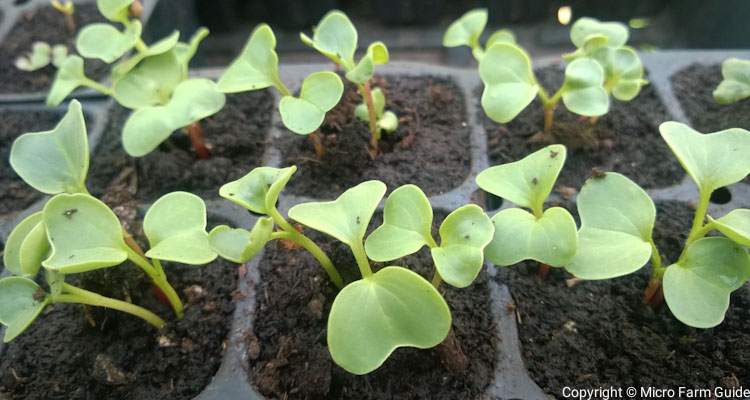
6. Prick Out Or Thin Seedlings
Thin the seedlings once they reach about 1 inch tall. You can use a micro-tip pruner or pair of small scissors.
I sometimes “prick out” or separate seedlings like lettuce, celery and thyme, then place them into individual cells.
This can be time-consuming but handy when seeds are limited or take longer to germinate.
Once thinned, continue caring for your seedlings by watering and applying fertilizer when necessary.
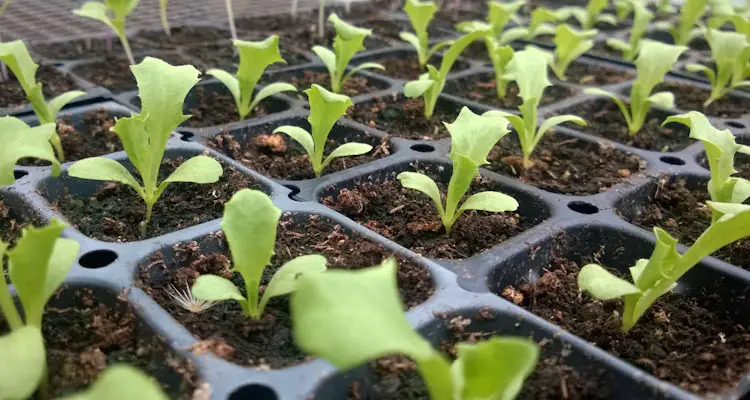
How To Start Seeds In Paper Towel
Some seeds, like lettuce, do not germinate well if the temperature rises above 80°F. As a result, you might need to pre-germinate them indoors. To do so:
- Fold a sheet of tissue paper, then place it into a small container to cover the entire bottom.
- Sprinkle some seeds onto the tissue, spacing them evenly to ensure they do not stick together.
- Spray the seed-covered tissue with some water. I normally use a small 500 ml spray bottle to do this. The spray nozzle provides a gently mist.
- Cover the container with the lid and place it in a cool area away from sunlight.
- Place the container in a cool spot, such as your bedroom, where they are easy to monitor.
You should notice a white root-like node emerging from the seed within 24 to 48 hours, at which point you can sow them as instructed above.
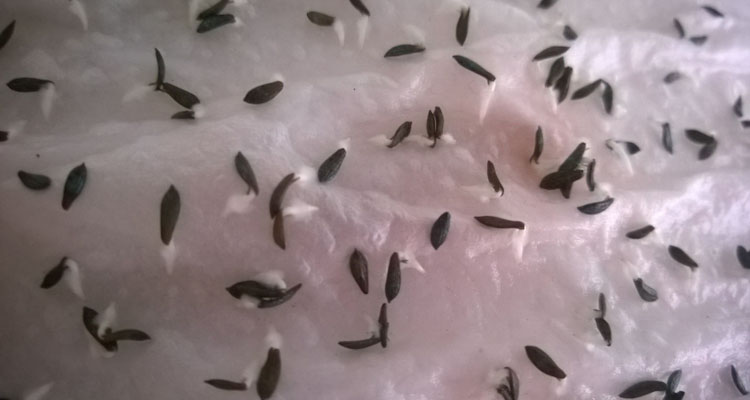
Final Thoughts
I used to take seed-starting for granted since it was more convenient to go to the nursery and purchase a few seedlings.
I still advise beginners to buy seedlings while learning how to sow their own seeds.
This can keep you motivated as you wait for your seed to germinate and give you a jumpstart on the growing season.
So, do not feel guilty if you purchase seedlings, especially seeds that can take weeks to germinate.
What matters most is that you use the skills and resources you have at your disposal to produce a bountiful harvest. Have fun!
Related Questions
How long do you leave seedlings in a seed tray?
You can leave seedlings in a seed tray for a few weeks, provided they are not large enough to touch each other. Consider thinning or transplanting seedlings into individual cells to give them enough space to grow properly.
What do you put in seed starting trays?
Use a peat or compost-based seed-start mix in your seed-starting trays. These mixes have little to no nutrients and can retain moisture without becoming soggy.
How do you prepare the soil for seed trays?
Ideally, you should not use normal soil for seed trays. However, if necessary, you should sieve and combine it with compost, in a 1 to 1 ration. Then moisten the potting mix before adding it to the seed tray.
References
Charles Dowding. Multisow For Many Benefits. charlesdowding.co.uk. Accessed March 2023

